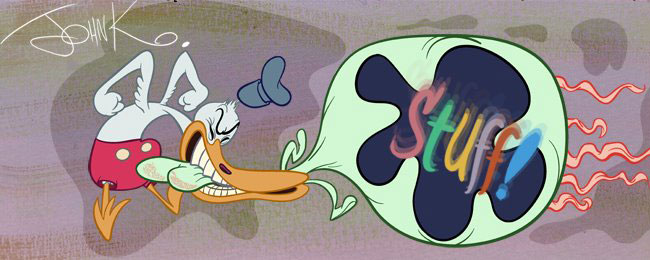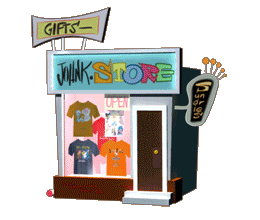

 Amid Amidi created the first animation magazine that really gave people who loved cartoons what they wanted in a magazine. They wanted rare art, interviews with lots of artists -known and lesser known- from every creative department in animation and some new opinions and insights that didn't follow the accepted ones that had been handed down for generations.
Amid Amidi created the first animation magazine that really gave people who loved cartoons what they wanted in a magazine. They wanted rare art, interviews with lots of artists -known and lesser known- from every creative department in animation and some new opinions and insights that didn't follow the accepted ones that had been handed down for generations.ANIMATION BLAST set the model for all the animation blogs that followed. Amid certainly inspired me to add my 2 cents worth every day.
The magazine is a classic and if you want to get back issues, better order them quick, because many of the issues have since sold out.
http://www.animationblast.com/inprint/backissues/
Here is an article from Amid's design issue. He interviewed me about my design hero, Ed Benedict.

There was one mistake in the article, and now I can correct it: This BooBoo model is the one I am talking about in the article.

Boo Boo Bear's profile looks completely different than his front view.
The BooBoo drawings printed in the article aren't Ed's. They are mine. I inbetweened Ed's 2 views of the character to show how to morph the one view to the next.




 I like looking at Ed's development sketches. He takes an idea and then does lots of variations of it, looking for a design that clicks. If it didn't click, he'll toss the concept and he'll try another idea and develop that- all the time waiting for a design that is not only a design, but an instant iconic character. In other words, when you look at the final design, it's so much a character that it just seems like it's always existed.
I like looking at Ed's development sketches. He takes an idea and then does lots of variations of it, looking for a design that clicks. If it didn't click, he'll toss the concept and he'll try another idea and develop that- all the time waiting for a design that is not only a design, but an instant iconic character. In other words, when you look at the final design, it's so much a character that it just seems like it's always existed.

These are all his exploratory sketches as he was hunting through his brain for the finished character.


 Ed was an animator long before he became a designer. He animated on Oswald cartoons in the 30s (with Tex Avery, Bill Nolan and other stars), then did storyboards and layouts for commercials and layouts for Disney in the 40s. In the 50s he got his first break at character design on Tex Avery's shorts. By this time he knew functionally how to design characters that would work for animation and not merely look "designy".
Ed was an animator long before he became a designer. He animated on Oswald cartoons in the 30s (with Tex Avery, Bill Nolan and other stars), then did storyboards and layouts for commercials and layouts for Disney in the 40s. In the 50s he got his first break at character design on Tex Avery's shorts. By this time he knew functionally how to design characters that would work for animation and not merely look "designy". 
Even so, the animators at MGM resisted what he was doing at first. They didn't like the "UPA style" and thought it was impossible to animate. Ironically, they did some of the best stylized animation ever. A lot better than the animation in UPA's own cartoons!
Tex, on the other hand, loved Ed's work and the only condition he gave Ed, was that each drawing had to make the gag work. Ed layed out Tex's cartoons following Tex's storyboard poses. He didn't just design the characters as many "designers" do today. The designs had to be functional. There is no better training to be a character designer than to be an animator first. Then you know the difference between what can work, and what will just cause problems for the animators. (This advice applies to storyboard artists and writers too)
When Ed started designing the characters for Hanna Barbera's TV cartoons in the late 50s, he had a double problem. He had to design to please Joe Barbera as well as the audience. Joe never liked the stylized characters and only went along with it because it was the fashion. Ed would do his exploratory designs and then have to pull them back to please Joe who didn't like anything "too weird".
By the late 60s, Joe had pulled everything back so much that everything became super bland and that was the end of fun cartoons. The Saturday Morning Age of cartoons and their awkward bland designs have since even influenced feature animation films which I never in a million years expected to happen.
WHAT MAKES A GREAT ANIMATION DESIGNER? (besides talent)
A solid foundation in traditional animation.
You have to understand the basics of how characters move, talk, act. The only way you can know this is by doing it. It's of no practical use to think you understand it in theory.
The best way to learn it is by animating simple rounded characters. Not stylized characters that rely on motion tricks.
In any job in animation, you want to be able to put your money where your mouth is. If you are expecting someone else to make what you do work, and they tell you it won't, you would want to be able to prove it by doing it yourself.
The ability to not be chained to it.
A good designer needs to understand the functions of animation, but also needs outside influences.
Animation has always been a small, mostly inbred industry.
It can benefit by animators with open minds, who don't want to merely animate generic characters smoothly - as most top animators do.
Designers need inspiration from a wide variety of sources- related arts such as illustration, caricature, comics, actors, performers, family and friends.
With lots of added inspirations, we can add much color and variety and humanity to our animation, without designing shapes that can't functionally work.

